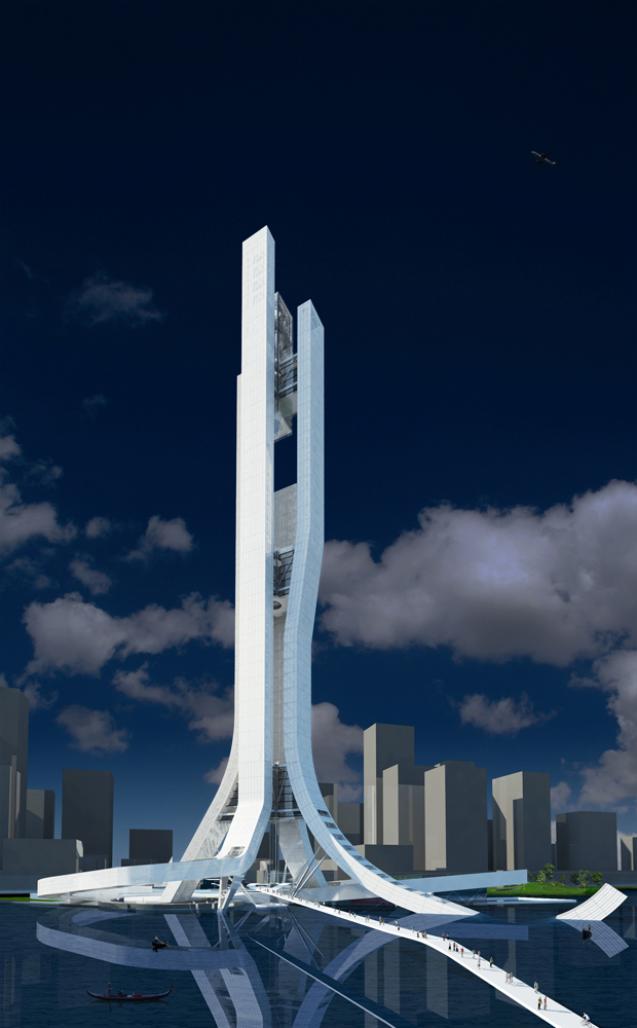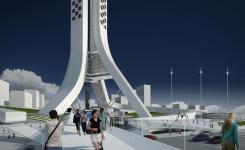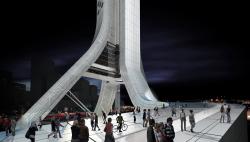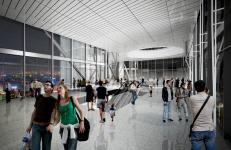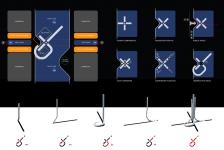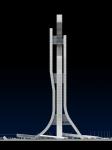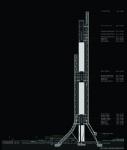Our approach was to develop an iconic tower form that is conceptually expressive of the confluence of regional energies which define the Cheongna area as Korea’s “Open window to the world”. Cheongna’s aspirations to create a global center for cultural and economic exchange in the center of Northeast Asia can be distilled into a symbolic form born of the emotion and spirit of the place. Conceptually, the landscape or horizontal ground plane is where these energies are individually peeled up and radically transformed into vertical elements to create the tower form. Not unlike the mountain landscape that surrounds Cheongna, horizontal forces in nature converge to create vertical movement and an eternal push skyward.
The tower form is composed of four independent rectangular legs which emerge out of the landscape from the southwest, northwest, northeast and southeast corners of the site. Not unlike the organic twisted surface roots of the Banyan tree, each of the four tower legs dramatically slope up towards a central convergence point along a unique path and geometry to create a grouping of almost touching towers. The four rectangular tubes ultimately converge around a vertical void space then become vertical to form an asymmetrical implied cruciform plan. The northeast tower leg shifts out within the midlevel volume and pulls away from the central void as it rises to the top to create an extended space between the legs. Each of the four towers ascends to a unique height with the southeast tower alone extending from the ground up to the 449m height limit. The resulting sinuous form is defined by the fluid transformation of the 4 trussed tubes from landscape into a vertical tower structure which dissolves into the sky.
At three distinct levels within the 449m height the tower legs are connected by suspended glass volumes within which the tower legs become integrated into the occupied interior space. The resulting stacked cruciform plans contain the multi-level lobby/observation program spaces, related amenity functions and service/mechanical space in discreet multi-level towers. The first level of each volume contains all mechanical and service related spaces, fire exit transfers and refuge areas. Typically there are two levels immediately above containing all amenity program elements including food service/restaurant and entertainment, multi function rooms, gallery space etc. The top levels of each volume are the observation decks which include the double-decker elevator lobbies and a variety of related spaces. Primary circulation between floors within each volume is by escalator.
The lower volume containing floors T101-T106 is located between +59m and +94m. This 6 story volume contains the first occupied spaces in the tower and is the primary vertical distribution point for the mid-rise and high-rise express elevators, the shuttle tube elevators from the underwater entry hall and the inclined elevators from the pedestrian ramp. The two amenity levels include a variety of restaurant spaces including a large outdoor covered terrace cut out of the connection volume overlooking the City Tower Plaza and the surrounding landscape.
The mid-rise volume containing floors T201-T205 is located between +205m and +230m. This 5 story volume contains the mid-rise elevator lobbies, observation decks and the related amenity spaces. This is the first observation level in the tower and places the viewer the equivalent of 60 floors above the ground. This observation experience can be related to the Rockefeller Center Top of The Rock in New York’s midtown in that the elevation places the viewer among the adjacent high-rise buildings.
The high-rise volume containing floors T301-T307 is located between +345m and +400m and is designed as a series of stacked vertical spaces interconnected by a circular central atrium. This penthouse multi-level volume contains the high-rise elevator lobbies, multi level observation decks and related amenity spaces. This is the highest group of observation levels in the tower and places the viewer the equivalent of 90 to 100 floors above the ground. The observation experience at this elevation is unique and offers distant views only possible in a select group of the tallest buildings in a handful of cities around the world.
At the upper 2 observation levels, the central volume rises up with the single full-height tower leg and culminates with soaring glass roof enclosure inscribed with a circular oculus in-line with the central atrium and voids. The vertical stacking arrangement of observation spaces within the tower transforms the observation deck experience into one of visual discovery as viewers climb through the levels individually crafting their own ascent to the top. The observation spaces encourage a more intimate exploration of the structure and the unique spaces within the structure. This intimate spatial relationship to the structure itself is what characterizes the delight of occupying the structure itself rather than a more conventional space supported by a separate and concealed tower structure. This is an essential element in the magical experience one has visiting the Eiffel Tower and is intrinsic to the development of the design of City Tower.
Lighting Design
The proposed lighting concept for City Tower is intrinsic to the development of an architectural image that can produce an emotional response and speak to the aspirations of Cheongna. Human perception of light tends to be a universally common experience as the effect of local culture is minimal. In this way, light can be interpreted as a universal or global language which we use to understand our built environment in relation to nature. The effective use of this language is critical for the legibility of the tower design.
Conceptually, our design proposes that the ground plane is peeled up at four corners to produce four unique vertical layers which together form the tower structure. This is the essential act which produces the abstract tower form. The proposed lighting concept is designed to follow this basic narrative. Exterior tower lighting shall be focused on creating and projecting the image of these four peeled planes moving vertically from the ground into the sky. White is often considered the colour of perfection, faith and purity and is the essential colour typically associated with energy and light. The proposed lighting design utilizes white light and is greatly enhanced by the luminescence of the pearlescent white finish proposed for the perforated aluminium façade cladding.
Although the tower legs are physically constructed as rectangular tubes, they can be lighted as volumes composed of four distinct flat surfaces. Lighting controls will permit the discreet illumination of the individual legs to be manipulated by the intensity and the presence or absence of light. This approach offers the opportunity to deconstruct the tower into four individual tower elements by placing some in darkness and ultimately, individual surfaces of light, by leaving only a particular surface bathed in light. It is this ethereal image of thin “light surfaces” originating in the landscape and reaching up into the night sky which is symbolic of the Cheongna’s essential quality.
In addition to this primary lighting strategy described above, the perforated aluminium cladding supports the application of a variety of back lighting, surface lighting, and projected multimedia and integrated led technologies. The largely uninterrupted vertical surface area of each tower leg provides a neutral canvas for an ambitious lighting program developed around significant cultural events, national holidays and yearly celebrations. This idea of the ‘neutral canvas’ suggests there is an interesting opportunity for a City Tower sponsored art program, or Artist In Residence program related to the tower lighting.
Materials and Systems
In thinking about the materials for the primary tower elements we look to build on the conceptual design narrative to inform the quality and nature of the surfaces and their relationships to each other. The essential tower form is generated by the converging four sinuous legs which emerge from the ground plane to form a cruciform configuration around a vertical void space. These rectangular volumes are conceived as smooth somewhat abstract objects which together form the seminal image of the tower that looks toward the future. These forms appear in the skyline as volumes of energy and light connecting the earth and sky. This ethereal and image is at once abstract and yet technically expressive of the underlying structural system through the subtle ghosting of the trussed-tube structure behind a diaphanous skin. The intent is to impart a precious jewel-like quality to the legs in support of the desire to create an image appropriate for a symbol of a city that will be the “Sapphire of the world”.
The exterior envelope of the tower structure is composed of 2 primary wall types.
Wall type 1 –Tower Legs
The 4 tower legs are uniformly clad in an open joint perforated aluminium panel skin. The density and size of the perforation can be varied to suit the specific requirements related to the location and orientation on the tower. The diaphanous surface will take on a range of abstract visual qualities from appearing almost transparent under certain light conditions to translucent approaching opaque in others. The trussed tube structures within will be revealed in varying degrees throughout the day creating an ethereal image that is responding to the environment and light conditions.
This effect is enhanced by the pearlescent white finish designed to create visual depth and a reflective quality that changes with the angle of reflection and observation. The luminescence and inherent iridescent qualities of this finish imparts a celestial and futuristic character to the skin.
Occupied zones within the tower legs incorporate a transparent floor to ceiling glass wall behind the aluminium skin. The visual experience from within the tower legs is unique and the density of perforation in the aluminium panels is modified in these occupied zones to provide more visibility.
Wall Type 2 –Center Volumes
The center volume of each of the three suspended program volumes is clad with a mechanically ventilated double curtainwall system. The curtainwall is composed of a single floor to ceiling monolithic exterior glass layer, a 100mm ventilation cavity with an insulated glass unit on the interior. The proposed curtainwall employs the latest in low –e glass technology to permit the maximum transparency and minimal interior reflectivity while meeting strict solar and thermal performance standards. The cavity features an integrated shade device that can be programmed to operate as required in changing daylight conditions. As the primary function of the occupied spaces within the tower is observation, the tendency is for occupants to remain in close proximity to the façade for extended periods. As a result, thermal comfort is of particular importance.
Wall Type 2a- Connecting Volumes
The connecting volume at each of the three suspended program volumes is clad with a variation of the type 2 ventilated double curtainwall with a large 2.5m wide module for uninterrupted viewing. The spandrel panel is recessed to permit the floor by floor ventilation of the façade.
MASTERPLAN AND SITE DESIGN
The Cheongna masterplan highlights the relative importance of the east-west canal passageway which bisects the Central Lake Park to define the primary pedestrian urban corridor through the city. In response, the cruciform plan of City Tower is positioned along the western edge of Central Lake Park centered on the east-west canal axis and rotated 45 degrees from the cardinal directions. The legs spread out to the 4 corners of the site boundary rotated off north to create four large axial voids under the tower.
Super-tall buildings of this scale should strive to transcend a purely sculptural or ‘object in the park’ quality to become an active urban catalyst. In this sense, the tower form needs to not simply occupy a central space within the park and provide a dramatic terminus point, but should define an urban room and preserve the continuity of public space through the site from east to west across the Park.
Not unlike the parabolic voids at the Eiffel Tower’s base within the Parc Champs de Mars, City tower’s sinuous legs fan out at the base to create a dynamic urban multi-level outdoor space defined by the trussed tube structures above and plaza architecture below. This is an essential urban design quality of the City Tower design which the preserves the visual corridor along the east west canal axis and north south axis and crafts a surreal visual and spatial experience. It is this informal space that bridges the more urban experience at the ground level with the more ethereal and emotional experiences within the tower structure.
The City Tower entry plaza extends east into the site at street level from the main north south blvd along the western edge of Central Lake Park. This major north south road has been named City Tower Blvd. The plaza is conceived as a public meeting place punctuated by a series of both architectural events and year round public performance events. The plaza will be the most vibrant and diverse large scale public gathering space in the city and will serve as the cultural and entertainment center of Cheongna.
From the plaza surface, a dramatic ramped entry volume extends up in a sweeping curve to form the southeasterly tower leg. This leg contains the ceremonial pedestrian access to the tower through an interior entry hall. The space incorporates a series of events and accommodates exhibits and audio-visual experiences and relates the experience to the tower’s movement skyward. This tower leg extends to 449m above the plaza level and is the only tower leg which extends to the full height limit relating the transformation from earth to sky to the entry experience.
Passage through the entry hall terminates at a group of inclined elevators which lead into the central entry volume located 60m above plaza level. A curving ramp extends out from the plaza to provide pedestrian access to the landscaped rooftop surface of the entry volume to provide a parallel exterior entry experience overlooking the South Lake.
The dramatic sweeping inner curve of the tower leg overlooks the edge of a large sunken outdoor plaza lined with a multi-level food court, restaurant and retail bar. From this sunken plaza level at -12m below the street level the Southeast tower leg emerges and passes through the space as it ascends skyward. The large opening is bisected by a floating water bridge providing uninterrupted canal passage from the east-west canal way across the void into the South Lake. This space will can host a number of outdoor events and performances and would be the ideal location for a seasonal skating rink not unlike the Rockefeller Center Plaza.
A curved glass pavilion located at the street entrance to the plaza contains visitor information, orientation, advance ticketing and Tour Group services for the multiple programs and activities within the tower complex.
The podium buildings containing the Visitor’s Center and amenities, an Aqua Park, Kid’s Park, City Tower Retail Center and court, service and below grade parking are conceived as a series of ramped earth works emerging from the landscaped plaza at the base of the tower in concert with the sloped tower leg geometry. The plaza surfaces ramp up to form walkable roof landscapes creating a diversity of experiences and vantage points to view the tower above and surrounding park. The roof landscapes are punctuated by clusters of linear glazed apertures which bring natural light down into the program spaces below.
The tower leg at the Northwest corner emerges from the plaza through a multi-level linear glass circulation spine which serves as the primary access to the main podium program spaces. This circulation space terminates in the cable car station at the northwest corner of the plaza and extends southeast under the tower center into a circular under water entry hall. The entry hall contains the twin shuttle elevator tubes which extend up through the sky lit oculus at the surface of the lake into the entry volume suspended from the tower above. This dramatic water to sky vertical entry experience provides a more direct alternative to the extended more horizontal pedestrian ramp entry sequence and connects directly with the below grade parking and other amenities within the complex.
The east-west canal passage way extends into the site from the west under and across the primary north south blvd where it dissolves into the City Tower landscape visible only through a series of large circular openings in the plaza surface which trace its path and connect the canal to the plaza and sky above. The canal passage way itself is conceived as a pedestrian retail “river walk” defined by a pattern of overlapping stone lily pads clustered together to form an infinite number of floating paths along the retail storefronts fronting the canal. The resulting waterway is characterized by a more unpredictable undulating path and provides an interesting contrast to the directional path of the canal space.
The footprint of the tower, podium massing and plazas creates a land mass that projects east into the center of the Central Lake Park. Projecting west from the mouth of the east west canal way toward the center from the eastern edge of the park is a second land mass containing the remaining significant program element. The lake passage is pinched at this point effectively creating a north and south lake connected by a smaller scaled channel. The effect is to create a point of visual tension where the eastern part of the park converges with the tower landmass.
The ‘Themed Village’ or ‘Euro Park’, conceived as a ‘Global Village Pavilion’ sits on the eastern side of the park within a curving landscaped peninsula. This retail, entertainment and cultural center is a circular glass volume within which interior exhibit and retail objects containing the cultures of the world are grouped into a village-like arrangement. The pavilion itself could function as a small scale expo site promoting the “Open window to the world” theme expressed in the IFEZ plan.
Although separated by the narrow lake channel, the eastern peninsula is connected to the western side by a delicate curving pedestrian causeway and is accessed from the eastern north south road and through the east west canal way.
The design also incorporates a delicate pedestrian bridge that extends up from the east west canal way to the east and west of the Park and subtly bypasses the tower by looping around the shuttle elevator tubes at the center of the tower void. This bridge allows pedestrians to take a journey across the width of the park at an elevated position and offers a unique experience of passing through the center of the axial voids formed by the tower legs. From within the Central Lake Park, the bridge is perceived as a thin line connecting the two sides of the city together.
Site Circulation
The City Tower Plaza is located directly off City Tower Blvd at the western edge of the site on axis with the east west canal way. The large public plaza is an extension of the Blvd sidewalk at elevation 0m and is the primary entry and distribution point for pedestrians visiting the tower complex. From this central location, pedestrians have access to the visitor’s center pavilion, tower leg entry ramp, landscaped roof levels, and the multi-level linear glass circulation spine which serves as the primary access to the main podium program spaces. This circulation spine provides access to the cable car station located at the northwest corner of the site, Aqua Park, kid’s Park, the retail court and sunken plaza, parking and the under water Tower shuttle elevator hall located below the tower’s central void. From various locations in the plaza, ramp access is provided to the Lake side promenade as well as the east west canal way at elevation -4m.
Primary vehicular access to the site is via two two-way entry speed ramps located along City Tower Blvd at the north and south edges of the plaza adjacent to the two main cross streets. These two ramps provide visitors by car with direct access to the below grade parking levels located at -9m and -12m below the plaza. The volume of vehicular traffic for this facility suggests a combination of below grade self-park areas, valet serviced areas and perhaps the use of an automated or robotic parking system.
A two-way truck/service ramp runs parallel to the north vehicular ramp and provides direct access to the central service /loading dock area located at -6m below the plaza. This central service area is the central distribution point for all service related circulation.
As the City Tower and related amenity facilities can expect a significant number of tour group visitors, a covered bus drop off/pick up area is located directly off the plaza along City Tower Blvd.
Vertical transportation
The City Tower design utilizes the vertical tower leg structures to house the primary elevator banks and stair towers. The typical tower plan takes a cruciform configuration defined by the four tower trussed tube legs, a central volume and the four connecting volumes. In the typical floor configuration, the southeast and northwest Tower legs contain the high-rise and low-rise elevators respectively. The southwest and northeast Tower legs each contain a fire stair tower.
The mid-rise observation levels and associated amenity levels are served by a bank of three double-decker elevators located in the northeast Tower leg. The center cab in each bank is a designated service/fireman’s lift. The mid-rise elevators extend from twin lobby levels 105/106 in the lower volume and run express to observation levels 204-205 in the penthouse volume. The plan offers the option to permit transfers to high-rise elevators at these levels.
The high-rise observation levels and associated amenity levels are served by a bank of three double-decker elevators located in the southeast Tower leg. The center cab in each bank is a designated service/fireman’s lift. The high-rise elevators extend from twin lobby levels 104/105 in the lower volume and run express to observation levels 304-307 in the penthouse volume.
A bank of two large shuttle elevators located at the -12m level extends from the underwater entry hall located below the Towers central void to provide access directly to the lower volume high-rise and low-rise lobbies.
Two shuttle elevators are located in the southeastern leg at the top of the ramped entry. These inclined elevators provide direct access from the ramped entry volume and landscaped roof level directly to the lower volume high-rise and low-rise lobbies.
2008
Client: Korea Land Corporation
Facility: Super-tall Observation Tower, Global village, Retail, Water Park, Exhibit Halls, Entertainment Facilities, Parking.
Site Area: 110,425 sm
Height: 449 m
Status: International Competition Proposal.
Design Architect: ZERAFA STUDIO LLC
Design Principal: Jason Zerafa
Design Team: Luis Carmona, Joaquin Boldrini-Lopez,
Carolina Meller, Hughy Dharmayoga, Katherine Moya Ramirez,
Joint Venture Architect: Gregory T Waugh Architect, AIA, Leed AP
Structural Consultant: Gilsanz Murray Steficek LLP
Structural Design Team: Ramon Gilsanz, Jessica Mandrick
Associate Architect: AATA Arquitectos.
